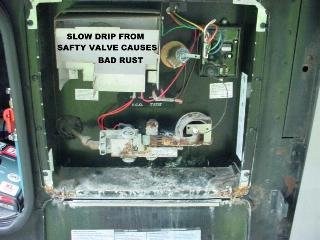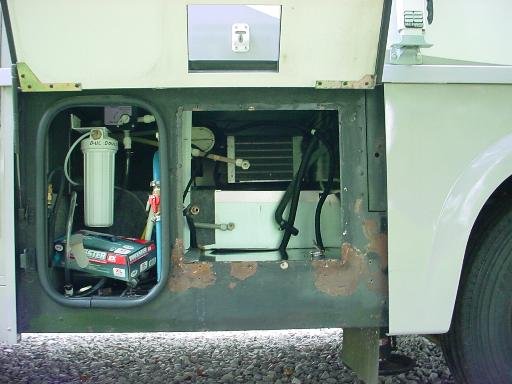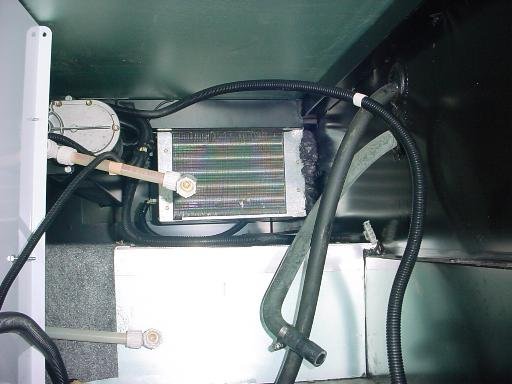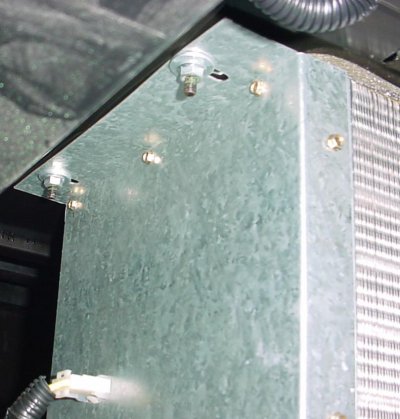Yesterday I had to ?wrassle? with the ?motoraid? heater hoses that bring hot engine coolant to heat the hot water tank and the Coach Heater (sometimes referred to as the rear heater) core when the engine is running. Once the heater hoses were removed I brought the WH outside on a bench with the 120V AC line still connected.
With that out of the way I removed the three screws that hold the Coach Heater to the platform it sits on. Now it becomes apparent that the heater hoses have to be removed from the wheel well side if the coach heater box is to come out. After pulling off most of the spray foam around the hose connections, my trusty and sharpened paring knife was called into service again to get these two hoses off the core nipples that project through the wall. Easily disconnecting the 4-pin electrical plug that also comes in from the wheel well wall, I was able to withdraw the heater unit and get to work on it out in the sunlight!
Removing screws that hold the galvanized sheet metal box together got me access to the fan & blower unit. Removing four more screws detached the blower housing from the galvanized outlet wall with the rectangular outlet opening in it. Yet another four screws separate the two plastic housing halves, and the motor and plastic squirrel cage blower are in my hands. The squirrel cage can be forced to turn, but clearly it is binding and moves only ?? on the periphery before in sticks again. Continued forced rotation results in a clicking sound every ?? as it rubs, then frees, then rubs, then frees. Note that this is only the motor and the squirrel cage; this is not interference with the blower housing, which is laying on the work table in two pieces. So, after removing the compression spring that holds (?) the cage on the shaft, with some tugging, I pull the squirrel cage a little away from the motor on the motor shaft. Presto! The blower spins freely! Thanks to some person in some thread on some forum, I implemented the washer solution. I pulled the squirrel cage off the shaft, dropped a simple washer on the shaft, pushed the squirrel cage back on all the way, and found that this held the blower away from the motor just enough to prevent the previous ratchety binding.
Testing the blower reveals that it works just fine . . . on high. But . . . not on low! So now I think I have to replace the resistor pack that is mounted next to the heater core. My next step is to research the part and acquire it, whether at a local auto parts store or at a Winnebago/Itasca dealer. Can anyone advise the best/quickest source?
Warning: By the way, for anyone who gets this far, do NOT apply power to test the blower motor while it is in your hands or lying on the table by itself. Despite its diminutive size, it is quite powerful. The speed and torque might easily destroy the squirrel cage or your fingers when it kicks to life! And I mean kick! Remount the blower in its housing for safe testing.
I know some photos would help, and I have taken many. But I haven?t had time to organize them yet. I plan to revisit this entire project in a procedure document, complete with pictures along the way. I have to get my heater fixed first! Have patience.




